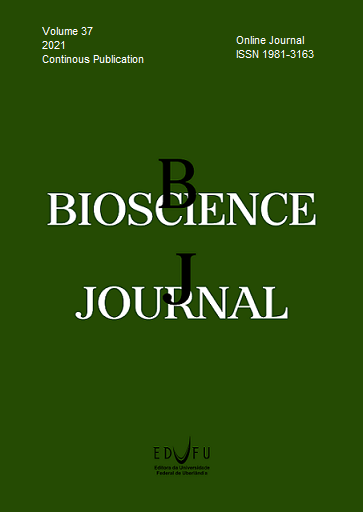Classification of the sperm chromatin compaction alterations in bulls (Bos taurus) and its correlation with the efficiency of the in vitro production of embryos
DOI:
https://doi.org/10.14393/BJ-v37n0a2021-47967Keywords:
Chromarin, Image analysis, IVF, Sperm analysis.Abstract
This paper proposes to classify the sperm chromatin compaction alterations in bulls, according to the affected area location and its objective is evaluating the correlation of the intensity, the heterogeneity and these kinds of chromatin decompaction with the rates of cleavage and the formation of blastocysts of in vitro production of embryos (IVPE). It was used several subfertile animals sperm samples, which were evaluated using the toluidine blue staining and computer image analysis, making possible the categorization of the chromatin decompaction according to their location. The percentages of chromatin decompaction and heterogeneity were also evaluated. IVPEs were done and the rates of cleavage and of blastocysts were correlated with the chromatin characteristics. It made possible the classification of the chromatin decompaction according to the head affected part in at least four types: base decompaction, basal half decompaction, central axis decompaction, total decompaction. Based on the correlation, it can be implicated that each type of classification has different influences on the bull fertility. It made possible understanding that sperms amount with 5% or more of chromatin decompaction intensity interferes in the bull fertility and this condition can be featured as an uncompensable defect, while the heterogeneity of chromatin is not an important factor in the IVPE results.
References
AITKEN, R.J. and DE IULIIS, G.N. Origins and consequences of DNA damage in male germ cells. Reproductive BioMedicine Online. 2007, 14(6), 727-33. https://doi.org/10.1016/S1472-6483(10)60676-1
ANBARI, F., et al. Does sperm DNA fragmentation have negative impact on embryo morphology and morphokinetics in IVF programme? Andrologia. 2020, 52(11), e13798. https://doi.org/10.1111/and.13798
BARTH, A.D. and OKO, R.J. Abnormal Morphology of Bovine Spermatozoa. Ames: Iowa State University Press, 1989.
BELETTI, M.E. Cromatina espermática: quebrando paradigmas. Revista Brasileira de Reprodução Animal. 2013, 37(2), 92-6. http://cbra.org.br/pages/publicacoes/rbra/v37n2/pag92-96%20(RB465).pdf
BELETTI, M.E., COSTA, L.F. and GUADIEIRO, M.M. Morphometric features and chromatin condensation abnormalities evaluated by toluidine blue staining in bull spermatozoa. Brazilian Journal of Morphological Science. 2005, 22(1), 85-90.
BELETTI, M.E., COSTA, L.F., VIANA, M.P. A computational approach to the characterization of bovine sperm chromatin alterations. Biotechnic and histochemistry. 2004, 79(1), 17-23. https://doi.org/10.1080/10520290410001700774
CARREL, D.T. Epigenetics of the male gamete. Fertility and Sterility. 2012, 97(2), 267-274. https://doi.org/10.1016/j.fertnstert.2011.12.036
CHACUR, M.G.M. et al. Efeito de meios diluentes na viabilidade de sêmen congelado bovino. Veterinária e Zootecnia. 2012, 19(1), 346-55.
EL HAJJ, N. et al. Methylation status of imprinted genes and repetitive elements in sperm DNA from infertile males. Sexual Development. 2011, 5(2), 60-69. https://doi.org/10.1159/000323806
EVENSON, D.P. The Sperm Chromatin Structure Assay (SCSA (R)) and other sperm DNA fragmentation tests for evaluation of sperm nuclear DNA integrity as related to fertility. Animal Reproduction Science. 2016, 169, 56-75. https://doi.org/10.1016/j.anireprosci.2016.01.017
FOLCHINI, N.P., et al. Uso de mini-Percoll modificado para seleção e redução da formação de espécies reativas de oxigênio (ROS) em espermatozoides bovinos. Revista Brasileira de Reprodução Animal. 2012, 36(4), 239-44.
GINEITIS, A.A., et al. Human sperm telomere-binding complex involves histone H2B and secures telomere membrane attachment. The Journal of Cell Biology. 2000, 151(7), 1591-98. https://doi.org/10.1083/jcb.151.7.1591
KIPPER, B.H., et al. Sperm morphometry and chromatin condensation in Nelore bulls of different ages and their effects on IVF. Theriogenology. 2017, 87(1), 154-60. https://doi.org/10.1016/j.theriogenology.2016.08.017
KUMAR, M., et al. Novel insights into the genetic and epigenetic paternal contribution to the human embryo. Clinics. 2013, 68(Suppl.1), 5-14. https://doi.org/10.6061/clinics/2013(Sup01)02
LUCIO, A.C., et al. Selected sperm traits are simultaneously altered after scrotal heat stress and play specific roles in in vitro fertilization and embryonic development. Theriogenology. 2016, 86(4), 924-33. https://doi.org/10.1016/j.theriogenology.2016.03.015
MELLO, M.L.S. Induced metachromasia in bull spermatozoa. Histochemistry, 1982, 74(3), 387-92. https://doi.org/10.1007/BF00493438
NAGY, S., et al. Sperm chromatin structure and sperm morphology: their association with fertility in AI-dairy Ayrshire sires. Theriogenology. 2013, 79(8), 1153-61. https://doi.org/10.1016/j.theriogenology.2013.02.011
OLIVA, R. Protamines and male infertility. Human Reproduction Update. 2006, 12(4), 417-35. https://doi.org/10.1093/humupd/dml009
POMINI, P.R.F., et al. Effects of FGF10 on bovine oocyte meiosis progression, apoptosis, embryo development and relative abundance of developmentally important genes in vitro. Reproduction in Domestic Animals. 2015, 50(1), 84-90. https://doi.org/10.1111/rda.12452
SAACKE, R.G. Sperm morphology: Its relevance to compensable and uncompensable traits in semen. Theriogenology. 2008, 70(3), 473-78. https://doi.org/10.1016/j.theriogenology.2008.04.012
SAKKAS, D. and ALVAREZ, J.G. Sperm DNA fragmentation: mechanisms of origin, impact on reproductive outcome, and analysis. Fertility and Sterility. 2010, 93(4), 1027-36. https://doi.org/10.1016/j.fertnstert.2009.10.046
SHAMMAS, M.A. Telomeres, lifestyle, cancer, and aging. Current Opinion in Clinical Nutrition and Metabolic Care. 2011, 14(1), p.28-34. https://doi.org/10.1097/MCO.0b013e32834121b1
SILVA, R.T., MENDES, J.J.O.B. and BELETTI, M.E. Compactação da cromatina e morfometria da cabeça de espermatozoides na produção de embriões “in vitro” utilizando touros zebuínos. Acta Scientiarum Animal Science. 2008, 30(4), 473-8. https://doi.org/10.4025/actascianimsci.v30i4.1002
SIQUEIRA, A.F.P., et al. Sperm traits on in vitro production (IVP) of bovine embryos: Too much of anything is good for nothing. Plos One. 2018, 13(7), e0200273. https://doi.org/10.1371/journal.pone.0200273
SOUZA, E.T., et al. Sperm chromatin alterations in fertile and subfertile bulls. Reproductive Biology. 2018, 18(2), 177-81. https://doi.org/10.1016/j.repbio.2018.04.001
TRASLER, J.M. Origin and roles of genomic methylation patterns in male germ cells. Seminars in Cell and Developmental Biology. 1998, 9(4), 467-74. https://doi.org/10.1006/scdb.1998.0225
WAGGONER, D. Mechanisms of disease: epigenesis. Seminars in Pediatric Neurology. 2007, 14(1), 7-14. https://doi.org/10.1016/j.spen.2006.11.004
WARD, W.S. and COFFEY, D.S. Identification of a sperm nuclear annulus: a sperm DNA anchor. Biology of Reproduction. 1989, 41(2), 361-70. https://doi.org/10.1095/biolreprod41.2.361
YAMAUCHI, Y., SHAMAN, J. and WARD, W.S. Non-genetic contributions of the sperm nucleus to embryonic development. Asian Journal of Andrology. 2011, 13(1), 31-5. https://doi.org/10.1038/aja.2010.75
Downloads
Published
Issue
Section
License
Copyright (c) 2021 Sara Hissae Hiraiwa, Paulo Henrique Mazzutti Alves, Bruno Augusto Nassif Travençolo, Muller Carrara Martins, Marcelo Emílio Beletti

This work is licensed under a Creative Commons Attribution 4.0 International License.





